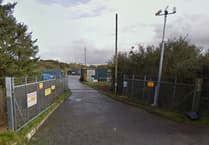The average house price in Ceredigion has fallen by more than 10 per cent, new figures have revealed.
Following record rises in recent years, the last quarter saw house prices in Ceredigion fall by 10.1 per cent, according to data released by the Principality Building Society, with the average home in the county now costing £241,321.
This is compared to an average price of £268,536 in December.
Year-on-year, prices have fallen by 3.2 per cent, but still remain among the most expensive in Wales.
By comparison, prices in Gwynedd have risen 5.1 per cent in the last quarter, with the average house now costing £234,388, up from £223,116 in December.
Powys has seen a slight fall in prices, with the average home now £253,036, £5,000 cheaper than in December.
Blaenau Gwent is the cheapest place in Wales to buy a house, with the average home costing £160,245 and Monmouthshire is the most expensive at £350,237.
It’s a mixed bag across Wales, with Pembrokeshire also recording a drop in prices, but Carmarthenshire seeing prices rise 2.7 per cent from last year’s price to an average of £221,370.
While affordability challenges remain, the steady rise in both prices and the number of transactions – which reached 10,000 in Q1– suggests buyer confidence is still growing, despite households continue to navigate cost-of-living pressures, an elevated rates environment and global economic uncertainty.
Overall, Principality Building Society research, based on HM Land Registry data, reveals that price declines in regional areas have eased over the past three quarters compared to the same period last year, offering some signs of stability for buyers and sellers in a shifting market.
Iain Mansfield, Chief Financial Officer at Principality Building Society, said: “The housing market in Wales has had a positive start to 2025, with prices rising quarter on quarter at their fastest pace in over two years.
Despite a challenging economic backdrop, we’re seeing a year-on-year growth of transactions, spurred on by supply challenges and falling rates. Meanwhile, affordability remains a key factor shaping the market landscape.”
A key driver of the year-on-year transaction growth could be the ongoing supply issues with the last 25 years seeing a notable decline in house building in Wales.
Significant policy changes such as the extension of the Welsh Government’s Help to Buy scheme, second home tax adjustments, and plans to build more affordable housing aim to combat this challenge and curb investor activity.
Iain continues: “Across Westminster and Wales, housing is high on the agenda. Looking ahead, the UK Government remains publicly committed to extensive planning reforms – setting out an ambitious target to build 1.5 million homes over the next 5 years, representing a significant shift in the UK’s housing landscape.
“This, paired with the Welsh Government’s Help to Buy Wales extension and additional £10 million investment allocated to kickstart housing schemes across Wales signals a clear message that policymakers recognise the importance of housing to families and individuals across the country.”



.jpeg?width=209&height=140&crop=209:145,smart&quality=75)

Comments
This article has no comments yet. Be the first to leave a comment.